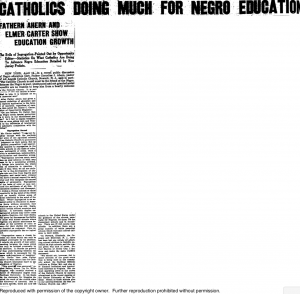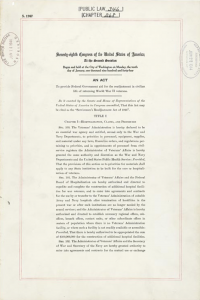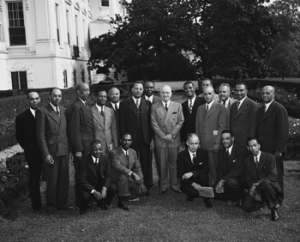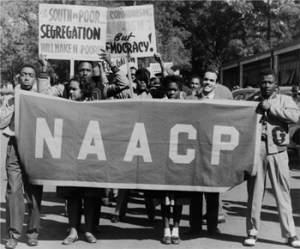Catholics Doing Much For Negro Education (1933)

This newspaper column is from Pittsburgh, Pa. Published by the Real Times, Inc. This newspaper gives first hand evidence and explanation as to why education and more specifically integrated education is most beneficial. Father Cornelius J. Ahern pastor, in an interview, mentions that the catholic church is on black people’s side and it has their best interest at heart, not because the catholic church has pity on them but because he has a soul just like everyone else. The pastor is against segregated education based on color or race, because it’s un-American, undemocratic, non-Christian and overall wrong. Educational segregation produces disrespect, snobbery, vicious concepts of race, it invites suspicion and mistrust and it begins a long-fostered hatred for blacks. Religion in the United States was before this time period used as a tool to dehumanize people of color and portray them as evil monsters that needed to be humanized. This poster proves that minorities are not what their stereotype deems them to be, and therefore introducing the idea that minorities specially Blacks are as human as Whites are and should not be discriminated against in education. Education was the new tool to help minorities escape the stereotype of evil and uncivilized humans that everyone believed them to be.
Servicemen’s Readjustment Act (1944)
 This Act was signed into law by president Franklin D. Roosevelt on June 22, 1944. This act along with providing World War II veterans with unemployment insurance and housing, it also provided them with funds for college education. This act provide a plan to achieve peace after the war that involves education, and killing two birds with one stone. This source discusses that education of the world will allow citizens to feel like they are citizens of the world. Education is defined as not being only improving literacy. Education should be provided for adults after wars and young people in order to give young people the chance to conclude the education process that was disrupted by the war. Though this was was well for white veterans the million of African Americans that joined the military during World War 11 failed to receive their share of benefits from this act [1]. The benefits were never received specially in the south where Jim Crow laws were still enacted and excluded Blacks from attending White schools.
This Act was signed into law by president Franklin D. Roosevelt on June 22, 1944. This act along with providing World War II veterans with unemployment insurance and housing, it also provided them with funds for college education. This act provide a plan to achieve peace after the war that involves education, and killing two birds with one stone. This source discusses that education of the world will allow citizens to feel like they are citizens of the world. Education is defined as not being only improving literacy. Education should be provided for adults after wars and young people in order to give young people the chance to conclude the education process that was disrupted by the war. Though this was was well for white veterans the million of African Americans that joined the military during World War 11 failed to receive their share of benefits from this act [1]. The benefits were never received specially in the south where Jim Crow laws were still enacted and excluded Blacks from attending White schools.
Leaders In Higher Education Photo (1946)

This image represents the improvement in diversity within higher education leaders. Almost all of the men in the image are of color, meaning that students of color have an influence to look up to. During the late 1930s public black colleges were taking a rise, this rise also stemmed the rise of private black colleges. These colleges were usually built on land grant and thus the name of black land-grant colleges. The rise of private black colleges was funded by major industrialist like Andrew Carnegie, John D. Rockefeller, and Julius Rosenwald. The reason for their involvement was to solely produce graduates skilled in trades that would take part in their industrial business. Though in the 1940s these industrialist powers started funding other causes, this left Black Colleges in a hurry to find a solution. The United Negro College Fund(UNCF) was created in 1944, composed of twenty-nine black college presidents in order to fund raise for the cause of black education. [2]
NAACP photograph (1947)

The National Association for the Advancement of Colored People (NAACP) was created in 1909. This association set out to become the legal defense of African Americans who underwent racially biased trials and were at high risk of being executed. The image above is a protest in which the association was protesting segregated education at the secondary and college level in Houston 1947. The NAACP main goal was to end segregation, and the way to most conveniently obtain this was through the grounds of education. The NAACP used education because it was the way and the technique used to quickly assimilate into the predominant white culture outside of the family culture. The inequality and segregation could be easily fought against education because forced segregation in schools will never mean equal education for both Whites and minorities[3] The NAACP decided to start this fight by focusing on segregated postgraduate education, because postgraduate education was the bridge that connected lower class economy to middle higher class opportunity. By means that postgraduate education would provide blacks with the education needed to take part in society alongside whites without any reprehensions on his knowledge not being up to part.
Notes:
- Weber, Brandon. “How African American WWII Veterans Were Scorned By the G.I. Bill.” Progressive.org. November 10, 2017. Accessed May 09, 2019.
- Gasman, Marybeth. “Higher Education.” Encyclopedia of African American History, 1896 to the Present: From the Age of Segregation to the Twenty-first Century, edited by Ed. Paul Finkelman. Oxford African American Studies Center, (accessed Thu May 09 00:45:58 EDT 2019).
- Conley Barrows, Leland. “National Association for the Advancement of Colored People.” The Oxford Encyclopedia of African Thought, edited by Ed. F. Abiola Irele. , edited by and Biodun Jeyifo. . Oxford African American Studies Center,
